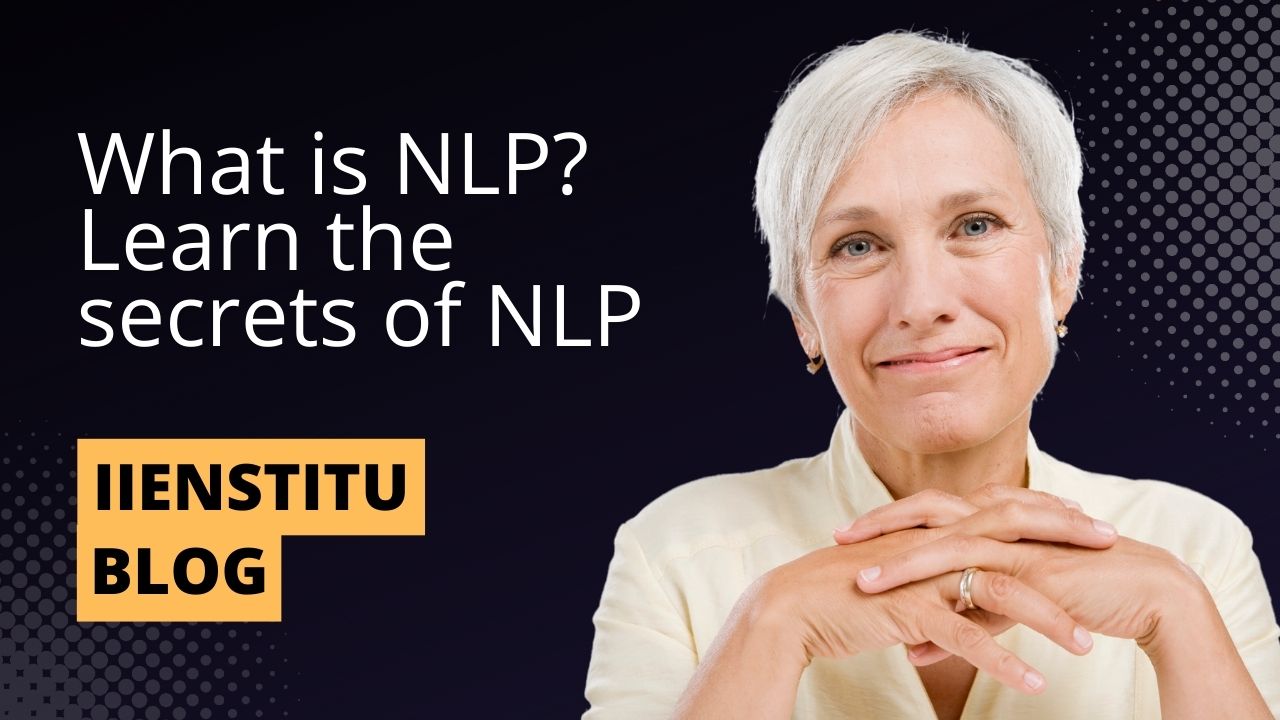
Quantum physicist Giulio Chiribella delves into explaining quantum information, quantum communication, and quantum cryptography. He also tackles the connections between quantum phenomena and consciousness, evolution, free will, and belief in God. Using quantum theory to explain everyday life may seem like another quantum leap into weirdness. But that is not what quantum theory's leading researcher for quantum information at Cambridge University, Giulio Chiribella, proposes. He says no one has yet found an explanation for all of quantum physics' strange behavior - such as entanglement (non-local correlations) or wave-particle duality (the ability of particles to act like waves). Scientists are trying hard, but they have not yet developed quantum explanations for quantum phenomena.
Chiribella has been looking at quantum physics in a new way. He has found that quantum theory can explain some everyday quantum mysteries, such as choosing the right partner when we want to start a family, why our actions seem to be free and not pre-determined by physical laws, and how we build trust and love relationships in life.
His results could make us think differently about what science is all about: "There are many people who try to solve problems in quantum physics," says Chiribella. "I am trying instead to answer questions in philosophy."
The Quantum Physics Behind Life's Mysteries
Scientists believe that an electron can pass through two openings simultaneously and then meet itself coming from the other side. This phenomenon is called quantum tunneling. Scientists also believe that particles can be in two places at once — another example of quantum tunneling — and they now think it's how we remember our past and process information.
"We want to find out if we put a particle into a state where you could say there is certainly one on one side and there is also one on the other side," physicist Andrew Truscott said in a statement from Australia's Commonwealth Scientific and Industrial Research Organization (CSIRO). "And if we try looking on both sides at the same time, does that particle disappear? This is a generalization of the famous thought experiment known as Schrodinger's cat, where a cat inside a box was considered to be both dead and alive at once."
The idea for such particles came from quantum physics, which states that tiny objects exist in multiple states — like the coin-flip example — until they are observed. The problem with quantum theory has been a lack of clarity on how large-scale things like people could exhibit these behaviors.
We know that electrons can act like waves sometimes (and behave like particles at other times). We also know that an electron fired through two openings at once will go through one or both, depending on spinning. So it's possible that our brains also process information like this.
"What we propose is that the very existence of the double-slit experiment itself means that reality has to behave like this," Truscott said. "People have been looking for years for where the duality aspect of quantum mechanics breaks down within our brains, but no one has ever found it."
For now, all we can do is wait and see if the researchers ever prove their theory correct.
The Quantum Physics and Life Philosophy
The nature of quantum physics is to make an attempt to investigate deeper into the nucleus of matter, which is extremely small in size. According to modern science, this tiny particle has nothing to do with life processes perceived by our sense organs. Yet, let's look at quantum particles somehow related to life processes, for instance, the Alpha Decay process. It will be evident that these particles are coming out from nuclei under certain conditions. Thus there may exist some connections between the quantum world and living beings.
The fact mentioned above can be proved through statements made by researchers working in the field of biophysics who state that "Quantum phenomena play an important role in biological systems.". While involving themselves in the microscopic world, these scientists have found that our planet is composed of atoms driven by quantum laws. How can we reconcile this fact with our notion of life? It will be more accurate to ask whether we can comprehend what has been discovered about the quantum phenomena or even know anything about it at all? What does life philosophy say on this matter?
To begin with, let's consider what contemporary scientists think on this issue. For instance, some try to compare Quantum Laws with Human Will-Power. Others attempt to do the same thing by presenting certain analogies between Quantum Physics and Psychology. In addition, they identify elements present in both sciences such as "observation," "unity," etc.
Finally, they draw a comparison between Quantum Physics and Life Philosophy. These comparisons claim a deep relationship between quantum phenomena and the philosophy of life. However, when we take a deeper look into their claims, it will become apparent that what they really do is make certain analogies based on inadequate information about both sciences. Moreover, if we approach this issue by discussing things in more detail, it would be possible to find out how "Comparative Analogy" can help us gain actual knowledge about them.
When trying to find some connections between philosophies of life and quantum physics, the first thing that should come into our minds is whether this topic has already been investigated by philosophers? If not, then perhaps it would be the first step to look at what they said about other scientific discoveries.
For example, the theory of evolution has been criticized by some philosophers because it deprives man of his "divine right" as far as creation is concerned. Is this comparison between Quantum Physics and Life Philosophy valid? To answer this question, we should consider what Darwin really meant by presenting his Theory of Evolution and what life philosophy says on the issue. In other words, we have to know that the aim of both theories is not to define man's rank in visualizing cosmos. Still, they have been formulated for explaining certain natural phenomena which have nothing to do with the purpose mentioned above.
On the other hand, if we compare quantum physics with the philosophy of life regarding their goals, an individual can easily comprehend that Quantum Physics studies the world as it is. Life Philosophy describes the world as we should see it. In other words, life philosophy tries to tell us how to organize our life. Thus, if we want to discover some similarities between these two sciences, we must look for a particular principle they both possess. The focus of Least Action can be seen in both theories. This principle introduced by Pierre Louis Moreau de Maupertuis in 1744 from within classical mechanics has been used so frequently by many scientists throughout history that one may claim that "the active principle" is the only common subject shared by quantum physics and philosophy of life.
You can be want to discover more about what this principle implies. Quantum life philosophy is a more profound subject and should be researched in detail. In that case, you can join Quantum Philosophy of Life and learn from an expert. Join IIENSTITU’s course!

Frequently Asked Questions
What are the mysteries of quantum physics?
Quantum Superposition and Entanglement
Quantum physics, also known as quantum mechanics, is a branch of physics that studies matter and energy at its most fundamental level. Despite its profound contributions to our understanding of the universe, the field is shrouded in mystery due to its strange and counterintuitive nature.
Wave-Particle Duality
One of the most discussed mysteries in quantum physics is the wave-particle duality. This principle asserts that elementary particles, such as electrons and photons, can exhibit both particle-like and wave-like behaviors. For example, electrons can interact with each other as discrete particles or exhibit wave-like properties when their position and momentum are measured simultaneously.
Quantum Superposition
Another puzzling phenomenon is quantum superposition, in which particles exist in multiple states or locations simultaneously until they are measured. This means that a particle can be in two different spatial positions or possess two different velocities at the same time. The famous thought experiment called Schrödinger's cat demonstrates this concept: a cat is placed in a sealed box with a radioactive atom that may decay and release poison gas. Until the box is opened and the cat is observed, it is considered both alive and dead according to quantum mechanics.
Quantum Entanglement
Quantum entanglement is another enigmatic aspect of quantum physics. It is a phenomenon wherein the properties of two or more particles become correlated in such a way that they are effectively dependent on each other, no matter how far apart they are. Albert Einstein famously called this 'spooky action at a distance.' Entanglement raises questions about the nature of reality and the limits of our perceptions.
Hidden Variables and Nonlocality
The notion of hidden variables was proposed to account for the strange behaviors observed in quantum systems. According to this idea, particles may possess additional, currently undetectable properties that determine their behavior in measurements. However, experiments such as Bell's theorem have shown that hidden variables cannot fully explain the observed phenomena, leaving the mystery of quantum behavior unsolved.
In conclusion, quantum physics is full of mysteries that challenge our understanding of reality. The wave-particle duality, quantum superposition, and quantum entanglement all showcase the counterintuitive nature of this field. While researchers continue to explore these phenomena and unveil new understanding, the mysteries of quantum physics continue to captivate both scientists and the general public.

How does quantum physics relate to life?
Quantum Physics and Biological Processes
Quantum physics, at its core, explores the behavior of matter and energy at very small scales. Within the realm of life sciences, recent developments have elucidated connections between quantum mechanics and vital biological processes. These quantum phenomena can potentially reshape our understanding of life's underlying mechanisms and offer insights into practical applications.
Photosynthesis and Quantum Coherence
One striking example of quantum physics' link to life is observed in photosynthesis, the process by which plants convert sunlight into usable energy. During photosynthesis, light-harvesting complexes efficiently transfer energy from photons to reaction centers. Quantum coherence, a phenomenon that allows particles to exist in multiple states simultaneously, has been observed in this transfer process. Researchers argue that this coherence enables efficient energy flow within photosynthetic systems, enhancing their functionality.
Cognitive Processes and Quantum Biology
Another area where quantum physics meets biology is in cognition and the human brain's processes. Quantum biology, a field that examines how quantum phenomena influence biological processes, has postulated that quantum mechanics plays a role in consciousness and decision-making. Theories suggest that quantum entanglement, where particles' states become interdependent, may facilitate communication between neurons. Additionally, quantum superposition has been proposed as a basis for understanding how the brain rapidly processes information, allowing for complex actions like decision-making and problem-solving.
Potential Applications in Medicine
A deeper understanding of quantum phenomena in biological systems may have practical implications in medicine. By investigating the quantum effects on enzymes and metabolic processes, researchers aim to develop new pharmaceutical treatments targeting key biological mechanisms. Precision medicine, a field that focuses on tailoring treatments to an individual patient’s genetic and environmental factors, could benefit from advances in understanding how quantum physics influences cellular function.
In conclusion, the interplay between quantum physics and biology is a rapidly emerging interdisciplinary field, revealing the profound connections between the very small and the very complex. Studying these phenomena, from photosynthesis to brain function and beyond, will enhance our understanding of life's underlying mechanisms, opening doors to potential applications in various scientific disciplines.
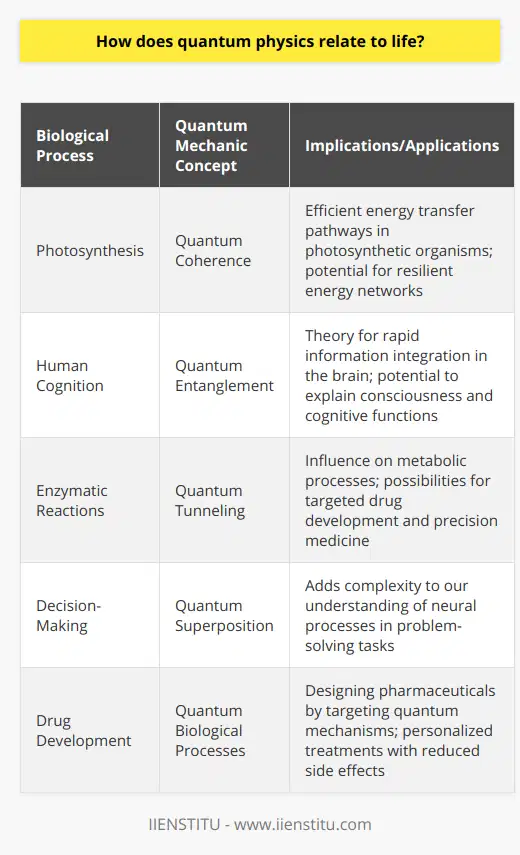
Why is quantum mechanics considered a mystery?
Challenging Classical Physics
Quantum mechanics remains a mystery primarily because it challenges the very foundations of classical physics. This departure from the conventional understanding of the physical world creates an air of perplexity surrounding quantum mechanics.
Wave-Particle Duality
A key enigma within quantum mechanics is the wave-particle duality. This concept suggests that particles, such as electrons, can exhibit both wave-like and particle-like properties. This contradictory phenomenon defies the classical notion that particles and waves are mutually exclusive, resulting in confusion.
Heisenberg's Uncertainty Principle
Another perplexing aspect of quantum mechanics is Heisenberg's uncertainty principle. This principle states that it is fundamentally impossible to simultaneously measure pairs of properties, such as the position and momentum of a particle, with absolute certainty. This principle contradicts classical physics, which upholds the concept of determinism - the idea that the future behavior of a system can be predicted from past events.
Quantum Entanglement
Quantum entanglement introduces an even greater level of bewilderment. When two particles become entangled, the properties of one particle become inexorably linked to those of the other, regardless of the distance between them. This phenomenon has been dubbed 'spooky action at a distance,' as it undermines the idea that objects separated in space should remain entirely independent.
Copenhagen Interpretation
The Copenhagen interpretation further adds to the enigmatic nature of quantum mechanics. This widely accepted interpretation postulates that quantum particles exist in multiple states simultaneously, only to collapse into one specific state upon being measured. This interpretation challenges the perceived reality and raises questions about the role of observation in determining an outcome.
The probabilistic nature of quantum mechanics deviates from the predictability of classical physics, making it a challenge for human understanding. In essence, quantum mechanics represents a significant departure from longstanding scientific beliefs, making it mysterious due to its unfamiliarity and its defiance of previously accepted principles.
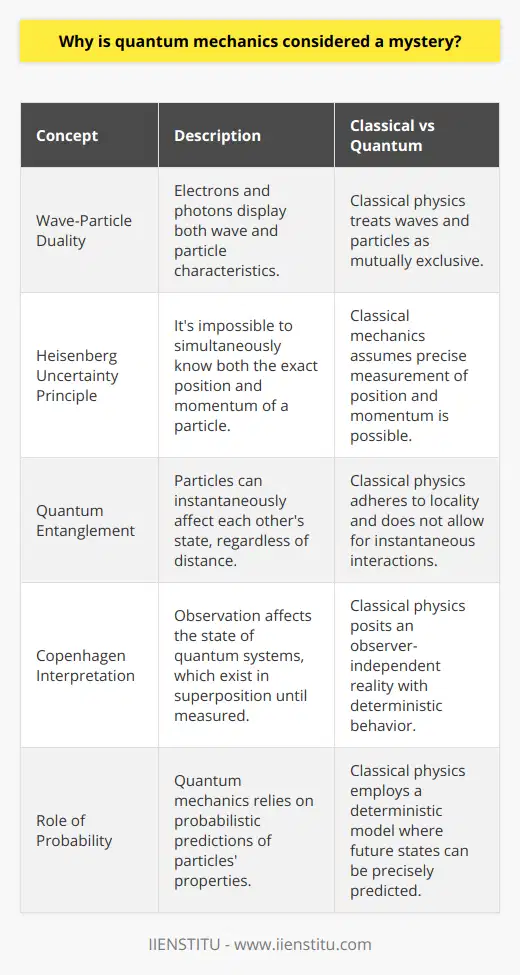
What is the quantum theory of life?
Quantum Theory of Life: An Overview
The quantum theory of life posits that the fundamental processes underpinning life's biological functioning are inherently influenced and dictated by quantum mechanics. This perspective extends beyond the classic understanding of biology, which relies on the macroscopic level of molecules and cells, to emphasize the impact of microscopic quantum phenomena on life's key mechanisms.
Life's Emergence and Evolution
A significant aspect of the quantum theory of life lies in its explanation for the origin and evolution of life. Proponents of this perspective argue that the same quantum principles that govern the behavior of atoms and subatomic particles also play a crucial role in forming the building blocks of life, including nucleotides and amino acids. Consequently, quantum mechanics has potentially guided the emergence of complex living organisms from simpler structures, shaping the process of evolution over time.
Quantum Effects in Biological Processes
In addition to providing insights into the origin and evolution of life, the quantum theory of life also sheds light on the microscopic processes that drive biological systems. One example is photosynthesis, where quantum coherence has been observed playing a role in the efficient energy transfer within plants. Another instance is the avian compass, where some bird species are believed to rely on quantum entanglement to navigate long distances.
Implications for Medicine and Biotechnology
Understanding the quantum mechanical basis of life has substantial implications for various fields, such as medicine and biotechnology. By incorporating the principles of quantum mechanics in our understanding of biological processes, researchers can potentially develop novel therapeutic approaches and enhance our ability to manipulate living organisms at the molecular level. For instance, quantum biology could pave the way for more effective drug design, targeted gene editing, and personalized medicine.
The Challenges Ahead
Despite its promising potential, the quantum theory of life remains a subject of ongoing research and debate. Many questions persist about the exact mechanisms through which quantum effects manifest in biological systems and to what extent these phenomena contribute to life as we know it. Future research in this interdisciplinary field will be crucial in refining our understanding of life's fundamental governing principles and opening new avenues of inquiry and application.
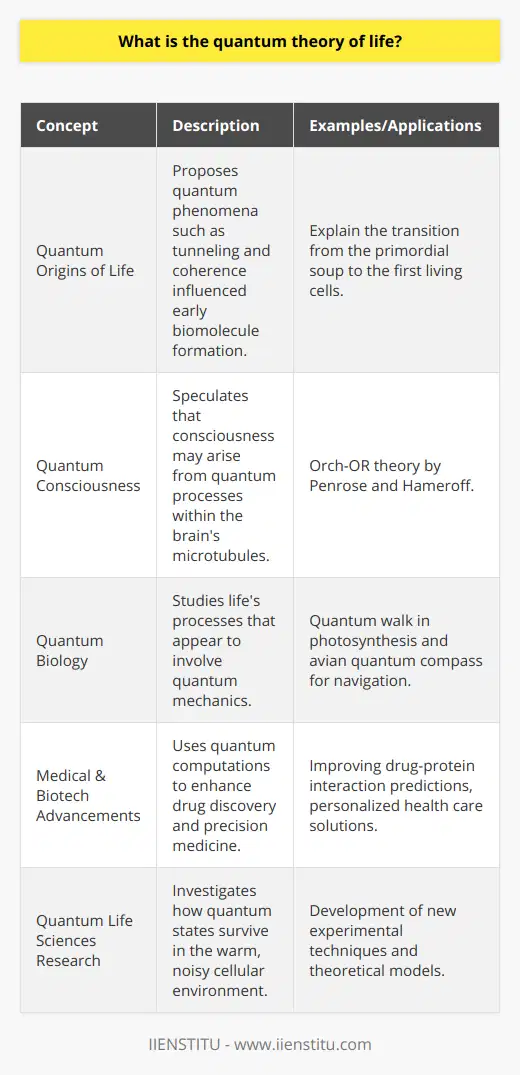
How does quantum physics contribute to our understanding of consciousness?
The Connection Between Quantum Physics and Consciousness:
Quantum physics, the study of the nature and behavior of matter and energy at the atomic and subatomic level, plays a significant role in shaping our understanding of consciousness. The concept of consciousness remains a mysterious topic in both science and philosophy, but recent theories propose that the two domains might be interconnected.
Wave-Particle Duality and Consciousness:
A remarkable finding in quantum mechanics, known as wave-particle duality, posits that particles can exhibit both wave-like and particle-like behavior. Some researchers speculate that this duality might help explain the enigmatic nature of consciousness. In this context, the dual aspects of matter and energy might parallel conscious experiences and mental processes, influencing how we perceive our surroundings and make decisions.
The Role of Quantum Entanglement:
Quantum entanglement is a phenomenon where two or more particles become correlated in such a way that the quantum state of one particle cannot be described independently of the others. This interdependence has led some theorists to propose that quantum entanglement might contribute to the formation of neural networks in the brain and the emergence of consciousness. The instantaneous exchange of information between entangled particles might provide a powerful mechanism for cognitive processes and decision-making.
Orchestrated Objective Reduction Theory:
One prominent theory that highlights a potential link between quantum physics and consciousness is the Orchestrated Objective Reduction (Orch-OR) theory, proposed by physicist Roger Penrose and neuroscientist Stuart Hameroff. The theory suggests that quantum processes in microtubules within neurons drive conscious experiences through a mechanism called objective reduction. According to the Orch-OR theory, these quantum processes could underlie our cognitive function and self-awareness, making quantum mechanics essential for understanding consciousness.
Conclusion:
While the relationship between quantum physics and consciousness remains speculative and highly debated, it is undoubtedly a topic whose exploration may lead to profound insights in both fields. Continued interdisciplinary research could unveil new aspects of the nature of consciousness, potentially impacting our understanding of the human mind and pushing the boundaries of modern science.
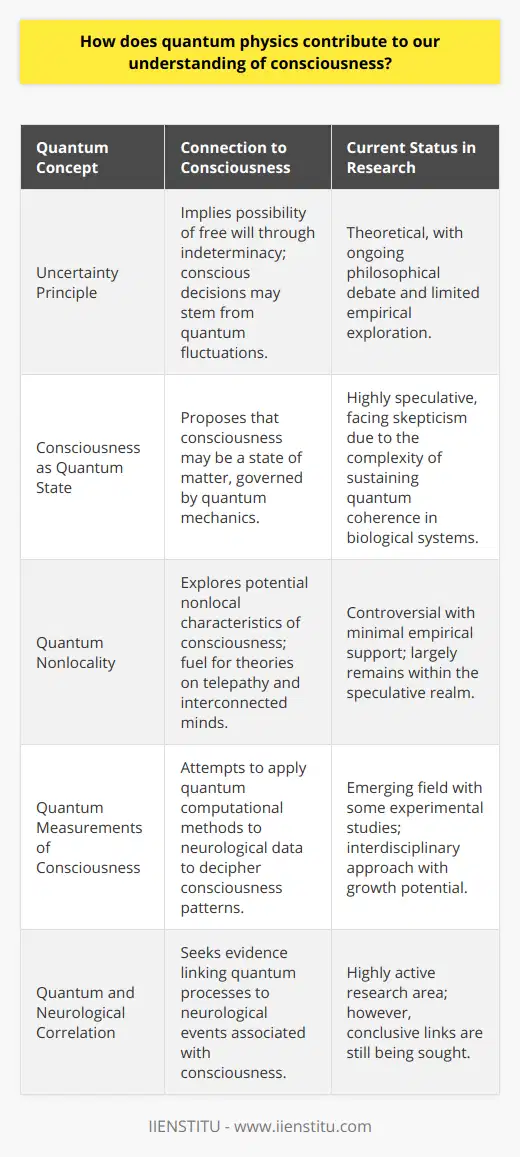
What role does quantum entanglement play in the study of biological systems?
Role of Quantum Entanglement
In recent years, the phenomenon of quantum entanglement has emerged as a significant topic in understanding complex biological systems. Quantum entanglement, a concept stemming from quantum mechanics, refers to the strong correlations between particles that remain connected even when separated by vast distances. Through this property, the behavior and state of one entangled particle instantaneously influences that of its counterpart.
Quantum Effects on Biological Processes
Researchers are increasingly recognizing that quantum mechanics influence biological processes. Photosynthesis, a key process for energy production in plants and some bacteria, exhibits quantum mechanical effects that enhance their efficiency. In photosynthesis, the excitation energy derived from sunlight is transferred to reaction centers, where it is converted into chemical energy. Experiments have shown that quantum coherence allows this energy transfer to occur more efficiently, improving photosynthetic yield.
Molecular Recognition Mechanisms
Quantum entanglement also plays a role in molecular recognition, a crucial aspect of many biological processes. Enzyme-substrate interactions, for instance, rely on precise and specific molecular recognition. Some researchers hypothesize that quantum entanglement within the enzyme-substrate complex can contribute to this specificity and facilitate the reduction of enzymatic transition state energy.
Implications for Medicine and Drug Discovery
The study of quantum entanglement in biological systems has significant implications for medicine and drug discovery. Understanding quantum-level interactions within proteins and other biomolecules can inform the design of novel therapeutic agents targeting key molecular pathways. Additionally, the incorporation of quantum-based insights can enrich pharmacodynamic models by providing more accurate descriptions of drug-target interactions, which can lead to more effective and targeted therapies.
Quantum Computing and Bioinformatics
Another area where the knowledge of quantum entanglement is applicable is quantum computing. These cutting-edge computational systems hold great potential for revolutionizing bioinformatics, the interdisciplinary field that combines biology, computer science, information engineering, and statistics to analyze large-scale biological data. By leveraging the principles of quantum mechanics, quantum computing can enable the analysis of vast amounts of data with unprecedented speed and efficiency. This capability holds promise for advancing research in genomics, proteomics, and other high-throughput '-omics' technologies.
In conclusion, quantum entanglement plays a vital role in the study of biological systems, providing insights into the efficiency of biological processes and molecular recognition mechanisms. Its applications in medicine, drug discovery, and high-throughput data analysis through quantum computing are paving the way for a deeper understanding of life at the quantum level.



